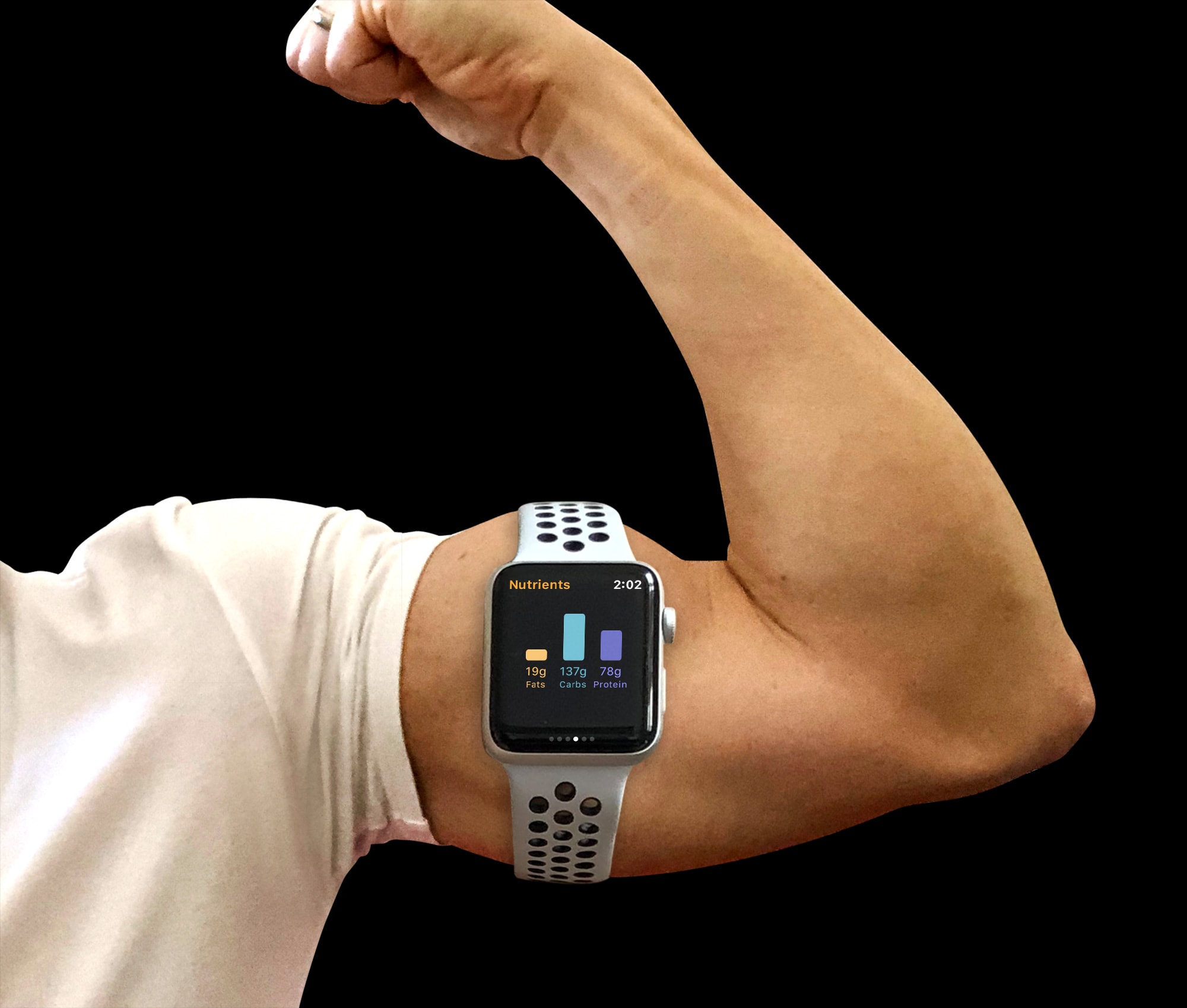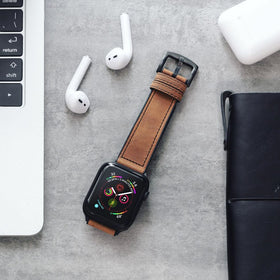How to build muscle with Apple Watch

If you diligently close your Activity Rings every day in the hope of getting ripped like The Rock, you are going about it all the wrong way.
Apple’s Activity app focuses on cardio conditioning and burning calories. Which is great for losing weight, but irrelevant if you want to build muscle.
In this post, we’ll take a look at what really makes muscles grow and how you can use your Apple Watch to make it happen.
Three essential ingredients for building muscle
There are three essential ingredients to building muscle: nutrition, overload and progression. If any one of these are missing, your muscles won’t grow. It’s that simple. To understand why, let’s take a quick look at when, how and why muscles grow. Then we’ll explore exactly how your Apple Watch can help.
Hypertrophy is the trophy we all want to win
Muscles come in all shapes and sizes. Pretty much everything that moves in your body is driven by muscle tissue. The heart is a special type of muscle. And then there are smooth muscles that control our internal organs.
But when most of us talk about muscles, we mean the ones you can see on your chest, arms and legs. These are known as skeletal muscles, because they are attached to your bones. When these muscle contract, they pull the bones on either side of a joint together to flex it, resulting in movement like walking, jumping or lifting weights.
The heavier the weight you lift, the harder your muscles have to work. Over time, they adapt to the demand you place upon them. If you lift a lot of heavy weights, your muscles get bigger in order to handler these loads more efficiently. This is known as muscular hypertrophy. And that’s exactly what we want.
The trouble is, maintaining big muscles takes a lot of energy. So if you stop using them to lift weights, your body starts trimming them back down, so they become smaller. This is known as atrophy. And that’s what we don’t want!
How to make hypertrophy happen
This bring us back to our three key ingredients of muscle growth: nutrition, overload and progression:
- Nutrition: muscle growth requires fuel, so getting your nutrition right is essential. That’s where our first app, Lose It! comes in.
- Overload: You gotta work your muscles hard to make them grow. For this, we’ll be using Centr by Chris Hemsworth and Nike Training Club.
- Progression: If you stop grinding, your muscles stop growing. To keep your gains on track you need to log your progress. For that we’ll be using Gymaholic and Body Tracker.

Photo: Graham Bower/Cult of Mac
1. Nutrition: Why Lose It! should really be called Gain It!
The majority of people downloading a fitness app want to lose weight. And that’s a very good thing, given that almost 40% of US adults are now classified as obese.
But we want to do the exact opposite. Adding muscle means you gain weight, not to lose it. Even if you also want to flatten your belly, you may still become heavier, because muscles weigh more than fat. So an app like Lose It! is useless, right?
Wrong.
Despite it’s name, Lose It! supports weight gain goals as well as weight loss. And thanks to it’s convenient macro tracking, it is a great way to ensure you are getting the macronutrients or ‘macros’ you need to support your muscle building goals.
Macros are the main building-blocks of our diet: carbohydrate, fat and protein. We need all three of them to survive, but the quantities we require vary.
Building muscle involves a process called ‘protein synthesis’ where your body literally uses the protein you eat to create new muscle tissue. So it’s important to make sure that you are eating enough protein, especially if you are a vegetarian or vegan.
Home much protein you need depends upon your body weight and goals. The National Institute of Health recommends a minimum of 0.36g of protein per pound of body weight for a sedentary person. But if you want to gain muscle you’ll need more than that. Check out this handy calculator to estimate your protein requirement.
The extensive database in Lose It! contains the macro breakdown of millions of different types of food, so when you log what you are eating, it automatically calculates your macros for you. Swipe-right on the Lose It! Watch app for a handy screen that summarises your daily macro breakdown in real time.

Photo: Graham Bower/Cult of Mac
2. Overload: why failure is a good thing
If you want to build bigger muscles, you have to embrace failure.
By failure, I mean repeating an exercise until your muscles become so exhausted that they fail to complete another repetition. Reaching failure is important because this sends a signal to your muscles that they need to grow bigger and stronger for next time.
Overloading your muscles in this way puts a lot of stress on them, so it is important to do the right exercises in the right way to avoid injury. Fortunately, there’s a wide variety of apps to choose from that provide how-to video demonstrations, to help ensure that your workout is safe an effective.
Centr is a new fitness app by ripped Avengers star Chris Hemsworth. It includes a wide selection of muscle-building workouts. These are a great place to start. Subscriptions are $19.99 a month, and you get your first week free. Check out my review of Centr for more details.
For a cheaper alternative, check out Nike Training Club, which offers over 180 workouts for free, (they have also recently introduced a premium tier at $14.99 a month). In the Workout tab, tap Workout Type and select Strength for a wide selection of muscle-building options.
Both Centr and Nike Training Club include Apple Watch apps that log your workouts and save them to Apple’s Activity app.

Photo: Graham Bower/Cult of Mac
3. Progression: force your muscles to keep adapting
The more strength training you do, the easier it gets. Which is great, right?
Not exactly. An easy workout is a sign that your muscles have adapted to the load. Which means that they will stop growing. So if you want to maintain your gains, you will need to increase the weights you are lifting.
That’s why it is important to keep a workout journal, to monitor your progress over time. In ye olden days, bodybuilders used to use tatty old notebooks or spreadsheets. But fortunately, these days there’s an app for that. There are plenty of gym logging apps to choose from, in fact. One good option is Gymaholic Workout Tracker.
With Gymaholic, you can log every time you do an exercise, including the weights you used and how many repetitions you completed. The app provides charts of your progress, which enable you to easily see when your gains have stalled, the dreaded “plateau.” This is a sign that you need to give your workout a refresh and try something new.
Gymaholic’s Watch app allows you to log weights and number of repetitions directly from your wrist during a workout, without even needing to take your iPhone into the gym with you.
In addition to logging the weights you lift, it’s also a good idea to keep track of the size of your muscles, since that is the whole point, after all. The body measurements you can log with Apple’s built-in health app are limited to your height and waist circumference.
That’s useful if you want to lose some belly fat. But if you are building muscle, you are probably more interested in measurements like the size of your biceps, chest and shoulders. This is where third-party apps like Body Tracker come in.
Body Tracker lets you log changes in the size of your biceps, chest, waist, buttocks, thighs and calves, and it provides useful diagrams and instructions to ensure you use your tape measure consistently and accurately. There’s even a feature that lets you take progress selfies and see the changes over time by overlaying them on top of each other.
Time to give your workouts some muscle
Big muscles look great, and getting ripped can certainly provide a great boost to your self-esteem. But there is more to building muscles than vanity. Research shows that regular strength training can reduce the risk of contracting a variety of diseases.
As we’ve seen, if you want to build bigger muscles, you need to do a bit more than just closing your daily Activity rings. But don’t let that put you off. Building muscle is something that pretty much anyone can do. It doesn’t even need to be difficult or time consuming, as long as you follow the principles of nutrition, overload and progression.



Leave a comment